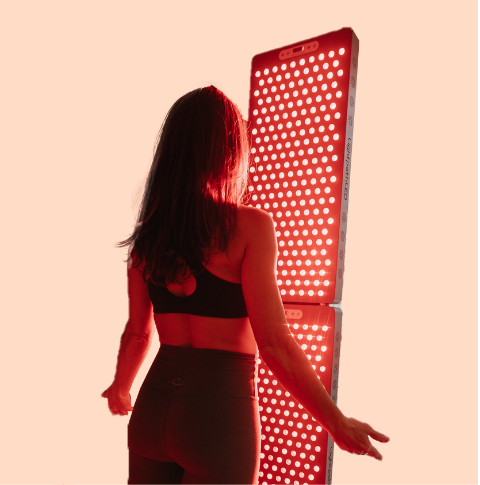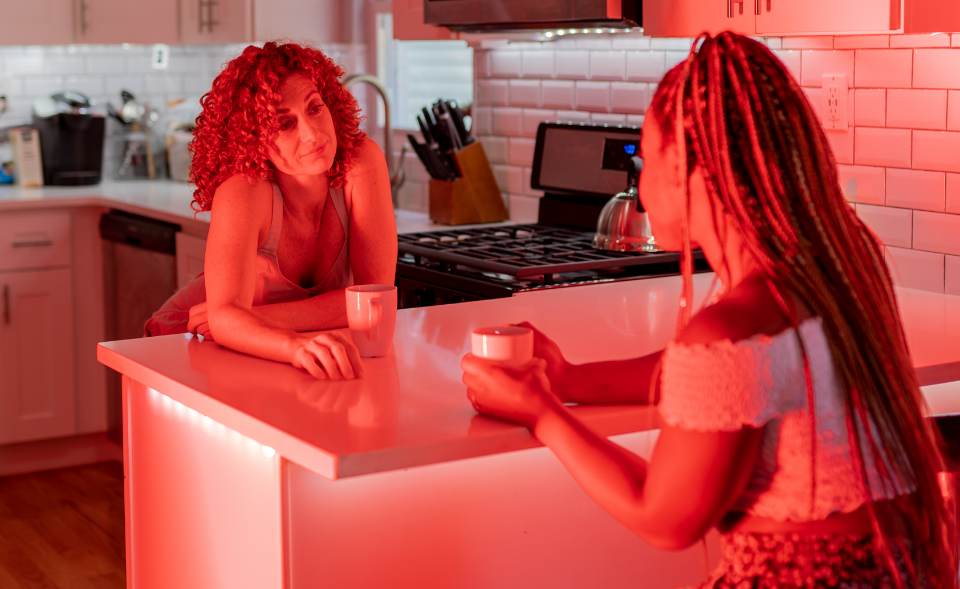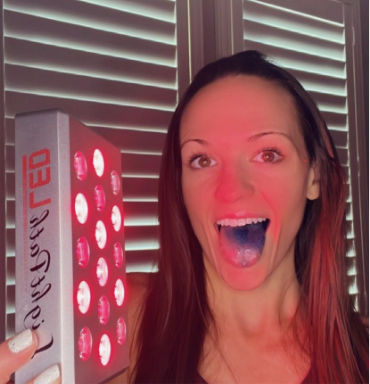Frequenty Asked Questions
No Result Found
How does red light therapy work?
Red light penetrates the skin, stimulating the mitochondria in cells to produce more energy. This can enhance cellular repair and regeneration.
How long should one session be?
When just starting out, you will want to begin at only 10-20% of the normal recommended session. Do this 3-5 times for the first week. You can then begin increasing the time over the next 2 weeks until you reach the maximum per body area. For example, if you’re using a Tabletop or larger, do 2 minutes per area at 12 inches away for the first week. Increase slowly so that by week 4 you are at 15-18 minutes per area at 12 inches away. If at any point you don’t feel well (yucky or headache), take a couple days off and begin again slowly. It’s recommended to drink plenty of clean water throughout the day. Treat this like exercise. You don’t want to push too hard too quickly. Take it slowly and gently.
What are possible side effects of red light therapy?
Not following safety guidelines can result in injury. Fortunately, when used correctly, light therapy has little to no side effects.
- Start slow. Read the previous question and answer.
- If you are photosensitive, don’t use.
- If you have issues with strobing light, do not use the pulse feature.
- For some people, using light at night might affect your sleep. For others they sleep much better. Everyone is different. If your device has blue, keep this off in the evening and night and just use red and NIR. Blue is best in the morning.
Should eye protection be used?
For individuals who have certain eye conditions such as diabetic retinopathy or who take medications that cause photosensitivity, or had recent surgery, precautions should be taken. These same individuals should also consult their primary healthcare provider before using light therapy. The light is very bright, so if it’s too bright, consider wearing goggles. Also the pulsing can be annoying and can be reduced by goggles. Otherwise, it’s recommended to keep your eyes closed. Light therapy has been shown in research to be very positive for eye health.
What does light therapy feel like? Will it get hot?
The devices themselve should not get hot but might feel warm partly due to energy loss from the device, but also due to the increased circulation to the body area exposed to the light. Most people find light therapy to be comfortable and relaxing.
What should I do once I complete a session?
Drink clean water. Hydration is important in general, but once you expose your body tissues and their cells to the light, their energy levels will go up significantly. Just like when you hit the gym for a workout, your cells need to stay hydrated when they are working out. Hydrating after a session gives your cells all the fuel they will need, as the energizing effects of light can last 48 hours! As a general rule, try to drink half your body weight in ounces per day.
How will I know if my light therapy is effective?
This is a loaded question as every person and every issue is different. Generally though, acute issues will resolve quicker than chronic issues. Consider light as a nutrient: even though you might not feel obvious changes, your cells do.
Is red light therapy safe for children?
It’s important to consult your child's healthcare provider before beginning any sort of red light regiment with them, but in general, research has been very positive.
What type of clothing should I wear when using a light panel?
Birthday suit is the best way to go! Clothing blocks the light waves from directly penetrating the skin, decreasing the effectiveness of the light.
How many sessions per week?
3 sessions is the minimum, up to everyday. This is per body area. So you can do your front day 1 and your back day 2 and continue to alternate, or you can do both in the same day and then take the next day off. If you prefer to do front and back everyday, go for it as long as you don’t feel you’re overdoing it. It’s good to take a day off from time to time.
What kind of contraindications are there to light therapy?
Light therapy is a safe and noninvasive therapy modality. However, there are certain medical conditions that fall under the category of contraindication. Meaning, if someone were to have a condition such as epilepsy, pregnancy, certain types of cancer, eye conditions, or on certain medications, light therapy may not be the right choice. Some of these contraindications have to do with a lack of human research. Consulting your primary health care provider before initiating light therapy is highly recommended.
Can I wear makeup during a light session?
It’s always best to have clean dry skin. Lotions and creams can lessen the penetrating ability of light. Certain lotions that contain retinol or similar, can create photosensitivity. Best to apply after the session.
Will my light interfere with any prescription medications that I take?
If you’re on prescription medications that fall into the category of tetracyclines, or if you take digoxin (An antiarrhythmic medication to treat heart arrhythmias) you should consult your health care provider before initiating light therapy. These and many other prescription drugs cause photosensitivity, which means it makes that individual’s body more sensitive to light (they can get sunburned easier, or their eyes can be harmed by intense light). Therefore, it’s important to consult your health care provider if you are on any kind of prescription medication before beginning light.
Can I wear contact lenses while using my light panel?
There is no harm to wearing contact lenses during your light therapy session, as you will likely have your eyes closed while you relax and enjoy the light. Some users have reported experiencing dry eyes while wearing their contact lenses during their light sessions, but that’s about the worst of it. Therefore, it is ultimately your choice on whether you’d like to keep your contact in or not, as there is no harm in doing so.
Can I use red light therapy if I’m pregnant?
It’s generally considered safe to use light therapy while pregnant, and may even be a safe alternative to antidepressant treatment. Depression is a very common condition to occur during and after pregnancy. But due to lack of human research, some doctors might advise not putting light directly on the abdomen. As always, this should be at the discretion of your primary health care provider.
Can cancer patients use red light therapy?
This has always been a controversial topic without a straightforward answer. There are studies showing that light can be beneficial to individuals with certain types of active cancer. Light has also been shown very positive for those going through and suffering the side effects of cancer treatments such as radiation and chemotherapy. It is highly recommended to consult your doctor first if you have or suspect you have cancer.
Is light therapy used to treat Seasonal Depression?
The use of light therapy has been in use for those who experience seasonal affective disorder for many years now. Blue light has been shown in research to be very positive for SAD as well as resetting your circadian rhythm to aid in deeper sleep. Best to combine blue in the morning with the healing benefits of red and NIR.
How does light therapy help with my athletic performance?
There are so many reasons why light therapy is so beneficial for an individual who works out regularly. The increase in blood flow that light promotes will allow your muscles to maintain optimal oxygen levels while you push them to become stronger. Not only will this enhance your ability to work out, but also help you recover from a workout faster. If your goal is to lose weight, light will also support this goal as an adjunct to exercise and diet.
Can I overdose on Red Light?
You can, in fact, overdose on light. More does not always mean better. Overexposing yourself to your light can negate the therapeutic effects. Fortunately there’s a wide therapeutic window for benefits, but it’s best to stick with the recommended session time per body area.
How far away should I be from the light?
This all depends on the device. Typically with the torch or pad, you’ll have skin contact or slightly away, while with the Mini, you’ll be from skin contact to 6 inches away. Any larger panels you’ll be 6-24 inches away. Keep in mind that as you move further away from the light source, the power you will receive will decrease, so you will need to increase the session time to achieve the same amount of total power. This decrease in power is due to the light reflecting off particles, molecules, moisture, ect. in the air.
How do I achieve a systemic effect with light?
With a larger panel, this is pretty easy as you’ll be able to get all of your body in a short amount of time. With a smaller panel such as a tabletop, it does require more time to get everywhere. With the torch, Mini, pads, you don’t have to, nor could you really get everywhere. So focus on the major lymph nodes and arteries.
How do I treat local issues?
It’s easy to put light right where the issue seems to be, such as a cut or pain. But we must remember that the body is a system with blood, lymph, and nerves that are all part of the healing process. So make sure that you also put light on those areas that supply the localized area in need. For example, if you have a sore wrist, put light there, but also the lymph nodes in the crook of the elbow and armpit. If there’s nerve pain in the feet, also hit the lymph nodes in back of knee and front of groin, also the lower back where the nerves feed the feet, as well as the legs that supply the blood to the feet.
Which wavelengths do I use?
If your device has red wavelengths and NIR wavelengths, you’ll almost always use both at the same time. As red penetrates skin deep and NIR penetrates much further, they compliment each other well. If your device also has blue, it’s best to use in the morning along with red and NIR. Using blue in the evening or night can disrupt circadian rhythm and make sleep difficult.
Can red light therapy be used in combination with other treatments?
Yes, light therapy is often used alongside other treatments such as saunas, vibration plates, PEMF, Rife, cold plunge. However, it's important to listen to your body and not overdo it. So if combining, start slowly.
Can red light therapy be used on pets?
Typically yes. The great majority of research has been done on animals. Many veterinarians use some form of light therapy to aid dogs and cats with skin issues, arthritis, kidney problems.
What is blue light therapy?
Blue light therapy involves using low-intensity blue light for various therapeutic purposes, including treating skin conditions, hair loss, regulating sleep-wake cycles, and reducing SAD.
Should I use just blue or combine blue with red and NIR?
It’s best to combine as red and NIR will penetrate much deeper than blue and create synergistic healing.
How does blue light therapy work?
Blue light can target specific skin bacteria, making it effective for treating acne (blue does not penetrate beyond the top layer of skin and thus will not be effective for deeper bacterial issues). It can also help improve eczema and psoriasis. Additionally, exposure to blue light can influence circadian rhythm and improve alertness as well as sleep.
Is blue light therapy safe for the skin?
When used as directed, blue light is generally safe. However, prolonged exposure may lead to mild side effects such as dryness or redness. When used beyond the recommended time, or when used later in the day, sleep can be disturbed.
Does blue light therapy impact sleep patterns?
Yes, exposure to blue light, especially in the evening/night, can influence circadian rhythm and potentially disrupt sleep. It's recommended to avoid blue light exposure close to bedtime. It’s recommended to use first thing in the morning.
Is blue light therapy suitable for everyone?
While generally safe, individuals with certain skin conditions, eye sensitivity, or those taking medications should consult with a healthcare professional before use.
Is there a recommended time of day for blue light therapy sessions?
For skin treatment, sessions can be done at any time (as long as the light is not directly entering the eyes, which will often be the case with facial acne or wrinkle treatment. Preferably avoid using later in the day or night). However, for circadian rhythm regulation or addressing mood disorders, morning exposure is often recommended.
Can blue light therapy be used for pain relief?
While red and NIR light is more commonly associated with pain relief, some studies suggest that blue light may have anti-inflammatory effects.
What is pulsing in red light therapy?
Pulsing refers to the rhythmic variation in light (basically the turning on and off, but at a specific number per second), measured in Hertz (Hz). For example, 40hz, means the light is turned on and off 40 times each second.
How does pulsing differ from constant light in therapy?
Pulsing involves intermittent light, providing potential benefits like improved cellular response compared to constant light.
Are there recommended pulsing frequencies for specific conditions?
Research is ongoing, but some studies suggest certain frequencies may be more beneficial for specific health concerns. Please consult with the list of presets to determine which pulse or pulses to use.
Can I use multiple pulse settings?
Yes. If you are doing a 15 minute session you could do half with a particular pulse and then do the second half with a different pulse. Or you can alternate on different days, so on Monday you use a specific pulse and then Tuesday you use a different pulse. It’s best to find just a couple pulses that fit your needs. You don’t want to overcomplicate things. There’s many overlaps in the benefits of the different pulse setting.
Are there specific contraindications for using pulsing light?
Individuals with certain medical conditions or taking photosensitizing medications should consult a healthcare provider before using pulsing therapy. It is advisable for those who suffer from strobing light induced seizures, migraines, dizziness, vertigo, etc. to avoid the pulsing feature. For some people, the pulsing light can be annoying or bothersome. It can take some getting used to. But if it’s too much of an issue, you can wear eye protection, a sleep mask, or turn off the red and just use the NIR, or raise the pulse to a setting over 80hz where the eyes cannot detect the pulsing. Otherwise, best to simply keep your eyes closed.
Is there a specific time of day that's best for pulsing?
Some users prefer using it in the morning for an energizing effect, while others find evening sessions relaxing. Experiment to find what suits you. Generally 40hz is best in the am, while 10hz or less is best in the pm.
As with any therapeutic treatment, it's crucial to follow guidelines, be aware of potential side effects, and seek professional advice for individualized recommendations.
Stay informed and be part of LightPathLED Movement

Why Pulsed Light?
Research indicates pulsed light therapy mirrors the brain's healthy rhythm to improve mental acuity, memory and attention

Join Our Community!
Join our robust Facebook group and do a deep dive on all things red Light Therapy. Ask questions about usage, product development, and the technicals in the community.

Become and Affiliate
If you have an audience that would be interested in LightpathLED, our affiliate program might be a great fit for you. We offer a competitive commission strategy for all of our products. Sign up to find out more information


